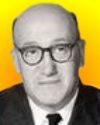Louis Essen, FRS
Father of the Atomic Clock
1908 - 1997

Early Years
Born in Radford, a suburb of Nottingham, in 1908, Louis Essen was from a modest background - his father was a shoemaker and repairer - but his natural ability won him a scholarship to High Pavement Grammar School. At the age of 16 he gained an open scholarship to University College, Nottingham. He graduated with a First Class Honours degree in physics and stayed on as a Ph.D research student during which time he met Albert Einstein who was visiting the university.
Early career at the National Physical Laboratory
In 1929 he cut short his postgraduate course and joined the National Physical Laboratory (NPL) as a Junior Scientific Officer in the Electricity Department. He was to remain at the NPL for the rest of his career. Initially he lived in digs in Teddington including with a family who kept a skiff at Constable’s boatyard in Hampton. Essen, always a keen sportsman, was able to make use of this at weekends. In the 1930s he undertook work on the frequency of radio oscillators and developed in 1936 the Essen ring quartz oscillator which remained the primary standard of time and frequency at the NPL until 1955.
In 1937 he married Joan Greenhalgh: they lived first in a flat in Park Road, Hampton Hill, and later moved to a house in Manor Gardens in Hampton.War and Post-war
During the Second World War Louis Essen worked on microwave frequency standards, essential for the accuracy of radar and radio navigation systems. He also found time to become an air raid warden. He began to research a new experimental method of determining the speed of light in a vacuum which he continued after the war. His findings, although initially viewed with suspicion, proved to be much closer to the value internationally agreed in 1988.
The Atomic Clock

By the late 1940s Louis Essen began working on the development of an atomic clock. Because resources were being concentrated on the construction of Alan Turing’s ‘Pilot ACE’ digital computer Essen’s work was delayed but by 1953, working with J V L Parry, he had created a caesium-beam atomic clock that was accurate to 1 second in 300 years. On 24 May 1955 Essen phoned Sir Edward Bullard, Director of the NPL, and invited him to come and witness the death of the astronomical second and the birth of atomic time. Essen’s work led to the internationally agreed definition of the second being based on atomic time. Louis Essen’s work was internationally honoured: he was elected a Fellow of the Royal Society in 1960 and was awarded the Rabi prize in the USA and the A S Popov gold medal in the USSR.
Challenging Einstein
Essen’s work on measuring time led him to take an interest in Einstein’s theory of relativity. To Essen’s surprise he found that some leading scientists disagreed about how to interpret the theory. Close analysis led Essen to conclude that Einstein’s theory contained basic and fatal flaws. His views were not welcomed as, perhaps naively, he thought they might be and he was asked to pursue this line of research in a private rather than an official NPL capacity. His conclusions were eventually published by the OUP in 1971 and, notwithstanding private support from many in the scientific community, he had to accept that he had failed to convince the scientific establishment.
Essen’s Legacy
Louis Essen retired from the NPL in 1972 and moved with his wife to live near Leatherhead. He died in August 1997 at the age of 88.
Accuracy in the measurement of time has improved, now equivalent to 1 second in 158 million years, but all of today’s methods are based on oscillations of atoms exactly like Essen’s first atomic clock.




